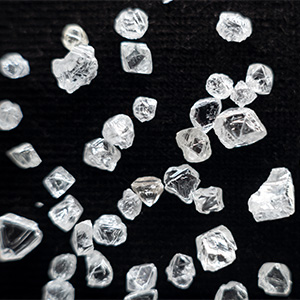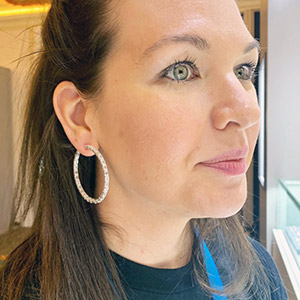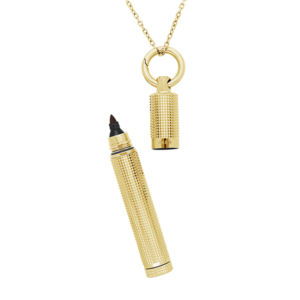
De Beers unveiled its turnaround strategy at a breakfast during JCK Las Vegas, rolling out a variety of initiatives meant to boost both the company and the overall natural diamond market.
Given that De Beers is up for sale, the breakfast event and its PowerPoint presentation seemed like a dress rehearsal for a financial road show. There were profit projections from chief financial officer Richard Lawson and some frank admissions from CEO Al Cook, such as his estimate that the lab-grown craze cost the U.S. natural diamond business 14% of the total market, or $7 billion, in 2023.
“We wanted the presentation to work on a number of levels,” Cook tells JCK. “We are very aware that everyone is very interested in what value there is within De Beers, so this was an opportunity to set out how we’re going to grow the company’s profits, and how we’re going to grow value.”
Perhaps the most notable announcement was the introduction of DiamondProof, a consumer-friendly countertop detection device for retailers—it measures 12 by 12 inches, and is “affordably priced,” the company said.
“When we ask people in the U.S. and in China, 50% of [consumers] tell us, ‘I don’t think we can’t tell the difference'” between lab-grown and natural diamonds, Sandrine Conseiller, CEO of De Beers Brands, said at the event. “But we know that we can.”
De Beers wants DiamondProof to be “everywhere,” she said.
“We will put the machine in the hands of jewelry designers, malls, the public,” said Conseiller. “We will film [it being used], and we will put that in the social space. So this idea that ‘we can’t tell the difference’ will disappear.”
While executives did not say what the device would cost, it could stretch some retailers’ idea of “affordable”: JCK has learned that De Beers is considering pricing DiamondProof at around $12,000.
Cook says that any price will “be substantially lower than [De Beers] SynthDetect machines it’s based on.”
He says the new equipment is “incredible. You can put your jewelry in there and test it literally within seconds. It’s very, very easy to use.”
(It will, like most diamond detectors, be able to verify mined diamonds as natural, but will refer most lab-grown diamonds for further testing.)
At the breakfast, Cook announced that De Beers will suspend production of lab-grown diamonds for jewelry purposes and hand over its Lightbox factory in Gresham, Ore., to subsidiary Element Six to become a “world-class [industrial] CVD production hub.”
The latter move has led some to wonder if Lightbox and De Beers’ private-label gem efforts are being phased out. Cook tells JCK that hasn’t been decided yet.
“Lightbox is a great brand, with a great value proposition,” he says. “For a [few months], we will maximize production of lab-grown diamonds in Oregon. That will keep enough of an inventory to keep Lightbox going for the foreseeable future, and then we’ll see how Lightbox develops as a brand and make those decisions.”
Asked whether Lightbox will eventually sell other companies’ production, Cook responds, “We’re not immediately worried by our lack of lab-grown diamonds.… One of the propositions for Lightbox is carbon-neutral and made in America. That’s a wonderful proposition. It’s a tough one to match. Let’s make those decisions as the time comes.”
He adds: “As the price of lab-grown price tumbles and tumbles and tumbles, two things happen. The first one is that it’s no longer value-accretive to manufacture lab-grown diamonds for jewelry in North America. The second thing is the value associated with synthetic diamonds for technology goes up. We can now provide them to high-tech companies, such as our partnership with Amazon, our partnership with [photonics company] Coherent, as a real value proposition.
“So we will take our factory in Oregon, which is pretty much the world’s greatest synthetic diamond factory, and pivot that from producing diamonds for jewelry to producing diamonds for technology solutions.”
At the Vegas event, De Beers didn’t give details on its “category-driving” (aka “generic”) diamond marketing campaign planned for later this year. But Cook says it will follow last year’s “Seize the Day” model, which De Beers ran in conjunction with retailers.
“One part of our marketing will be with Signet,” he says. “Another part will be with [Chinese jeweler] Chow Tai Fook. And the largest part will be building on ‘Seize the Day’—it will be working with independents, it will be working with the Natural Diamond Council, it will be getting behind the DiamondProof synthetic detection. The long and short of it will be creating a new level of desire, a new diamond dream.”
As far as a possible De Beers sale by majority owner Anglo American, it’s “too early to say” who the buyer might be, according to Cook.
“We expect this process to take 12 to 18 months, and we have just fired the starting gun,” he says. “There’s two possibilities: One is a sale; the other is a demerger, where the shares get split, and both companies go their separate ways. We think either is a possibility.”
Cook says he’s looking at a sale with “excitement, and I genuinely mean that.
“If you look at [why] De Beers [is] at JCK, we’re here about the love for diamonds, the desire for diamonds, the retail excitement for diamonds. And the home for that is obviously not a mining company. As De Beers goes its separate ways from Anglo American, we have the opportunity to really fulfill our strategy.”
At the breakfast, Cook said De Beers’ Tracr technology will allow it to “venture into the sale of premium polished diamonds with an unrivaled story line, starting at the source.”
He admitted that 2023 was an “exceptionally bad year” for natural gems, as “success in [2021 and 2022] became a burden.” But he predicted the market will bounce back as Chinese demand and engagements increase, and the lab-grown and natural diamond markets continue to bifurcate.
“Lab-growns have certainly had an effect on natural diamond demand, but their prices are collapsing,” said Cook, adding that price declines “are driving the bifurcation, the splitting, between natural diamonds and LGDs.
“As the two product categories increasingly reside in different price brackets, they will see less direct competition. Look at lab-grown rubies, lab-grown emeralds, sapphires—they have all been through the same evolution process we are now seeing with LGDs. And they compete with semiprecious stones, or fashion jewelry, rather than with their natural counterparts.”
Cook predicted that by the end of the decade, 90% of the lab-grown market won’t compete with naturals.
He also touted a new study that Boston Consulting Group did in collaboration with De Beers, which said diamond prices can be expected to increase approximately 3% to 5% annually for the next few years.
Additionally, Cook announced that as part of De Beers’ plan to trim $100 million from its budget, the company will pause all exploration in Canada and focus on Angola. It will also sign its sightholders to new contracts in 2025. (The last contracts were signed in 2021.)
Lawson said De Beers will no longer provide reports following each sight, but will “provide greater transparency with more detailed reporting on a quarterly basis.”
(Photo courtesy of De Beers)
- Subscribe to the JCK News Daily
- Subscribe to the JCK Special Report
- Follow JCK on Instagram: @jckmagazine
- Follow JCK on X: @jckmagazine
- Follow JCK on Facebook: @jckmagazine







